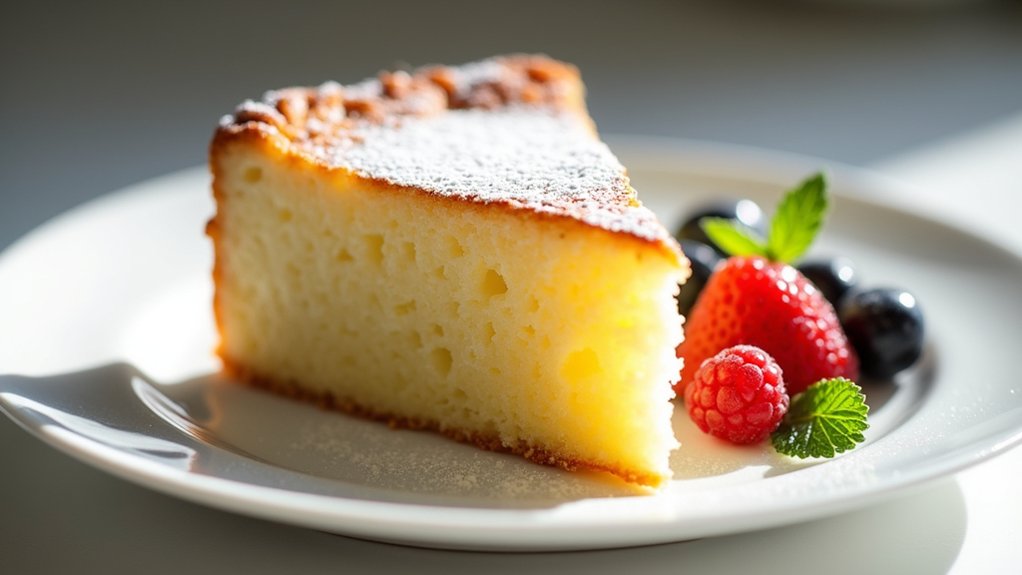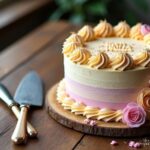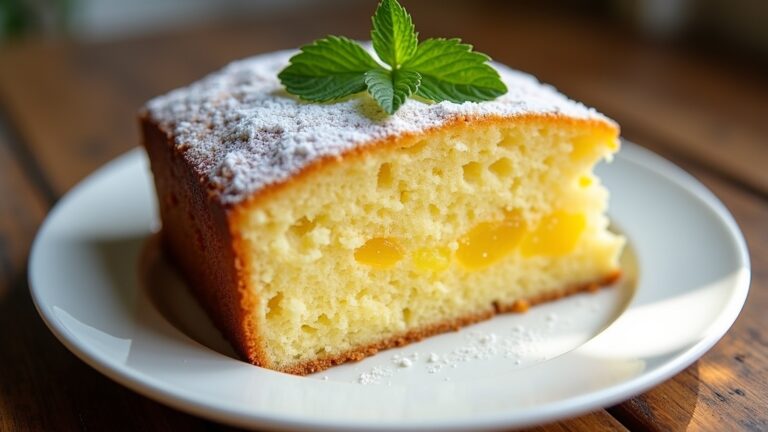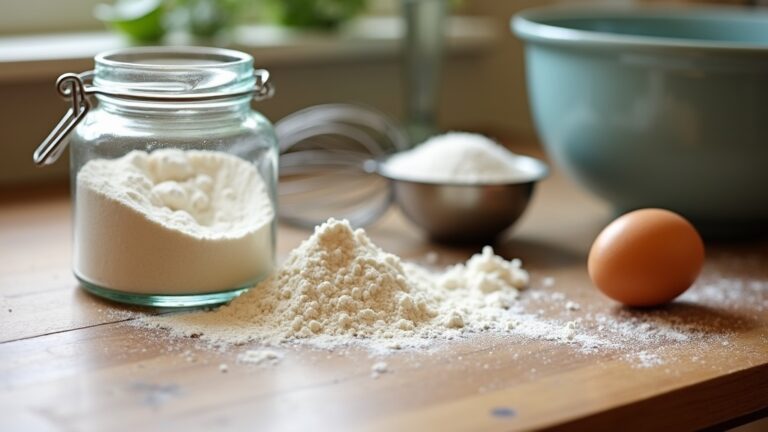Butter Cake Recipe
I’m excited to share my go-to butter cake recipe! You’ll need simple ingredients like unsalted butter, sugar, eggs, and flour to create a moist, indulgent treat. Just cream the butter and sugar, mix in the eggs, then combine the dry and wet ingredients. Bake until golden, and you’ve captured the essence of this classic dessert. It’s perfect for any occasion! If you’re enthusiastic to explore flavor variations and personalization tips, there’s so much more waiting for you!
Contents
History
When I think about the history of butter cake, I can’t help but marvel at its evolution over the centuries. Its origins trace back to the early days of baking, where simple ingredients like flour, sugar, and butter came together in rustic kitchens. This cake embodies the rich baking traditions of various cultures, adapting to local tastes and techniques. The buttery richness we adore today blossomed in the 19th century, showcasing the artistry of pastry chefs. I find it fascinating how butter cake has become a canvas for innovation, inspiring countless variations. As we explore this beloved dessert, we celebrate not just its deliciousness but also the stories and traditions that shaped it into the timeless treat we enjoy today.
Recipe
Butter cake is a classic dessert that embodies simplicity and indulgence. With its rich, buttery flavor and moist texture, it serves as a perfect base for various toppings or can be enjoyed on its own. This cake is not only easy to make but also a favorite among both novice and experienced bakers. Whether you’re preparing for a special occasion or just want a sweet treat to enjoy with your afternoon tea, this butter cake recipe is sure to satisfy.
To achieve the best results, it’s important to use room temperature ingredients, particularly the butter and eggs, as they blend more easily and create a smoother batter. Additionally, don’t rush the creaming process; taking your time to properly cream the butter and sugar will help incorporate air into the batter, leading to a lighter cake. With these tips in mind, let’s explore the ingredients and cooking instructions for this delightful butter cake.
Ingredients:
- 1 cup unsalted butter, softened
- 2 cups granulated sugar
- 4 large eggs
- 1 teaspoon vanilla extract
- 3 cups all-purpose flour
- 1 tablespoon baking powder
- 1/2 teaspoon salt
- 1 cup milk
Cooking Instructions:
Preheat your oven to 350°F (175°C) and grease a 9×13-inch baking pan. In a large mixing bowl, cream together the softened butter and granulated sugar until the mixture is light and fluffy. Add in the eggs one at a time, mixing well after each addition, and then stir in the vanilla extract. In a separate bowl, whisk together the flour, baking powder, and salt. Gradually add the dry ingredients to the wet mixture, alternating with the milk, and mix until just combined. Pour the batter into the prepared baking pan and smooth the top. Bake for 30-35 minutes, or until a toothpick inserted in the center comes out clean. Allow the cake to cool in the pan for 10 minutes before transferring it to a wire rack to cool completely.
Extra Tips:
For added flavor, consider incorporating lemon zest or almond extract into the batter. You can also enhance the cake’s texture by folding in some chopped nuts or chocolate chips. If you want to make the cake even more decadent, serve it with a dusting of powdered sugar or a dollop of whipped cream. Remember to store any leftovers in an airtight container to keep the cake moist for several days. Enjoy your baking adventure!
Cooking Steps
Now that we’ve gathered our ingredients, let’s get started on the cooking steps that will bring this butter cake to life. First, I always preheat my oven to a warm 350°F, creating the perfect environment for baking. Then, I cream the butter and sugar together until it’s light and fluffy, setting the stage for a deliciously moist cake.
Step 1. Preheat Oven to 350°F
Preheating the oven to 350°F is an essential step in baking the perfect butter cake. This ideal oven temperature guarantees that the cake bakes evenly, creating that rich, buttery flavor and tender crumb we all dream of. While the oven warms up, I like to gather my ingredients, allowing them to reach room temperature for better blending later. One of my favorite baking tips is to use an oven thermometer; it assures accuracy and consistency, which are vital in achieving that delightful rise. Once the oven beeps, signaling it’s ready, I feel a wave of excitement. Now, I can plunge into the next steps of this delicious journey, knowing I’ve set the stage for a scrumptious cake.
Step 2. Cream Butter and Sugar
Starting with softened butter, I scoop it into a mixing bowl, feeling the creamy texture beneath my fingers. The butter’s rich flavor and moisture will be the foundation of my cake, showcasing its benefits like adding tenderness and depth. Next, I sprinkle in my chosen sugar type—granulated for sweetness or brown sugar for a hint of caramel. I grab my electric mixer and blend them together until the mixture is light and fluffy. This essential step incorporates air, ensuring my cake rises beautifully. As I watch the butter and sugar transform into a pale, velvety cream, I can already imagine the delicious cake it will become. This harmonious blend is where magic begins!
Step 3. Add Eggs One at a Time
Adding eggs one at a time is essential for achieving that perfect butter cake texture. This step allows for ideal egg incorporation, which is key in baking chemistry. As I crack each egg into the creamy butter and sugar mixture, I can almost feel the batter transforming. Whisking it thoroughly after each addition guarantees that the eggs blend seamlessly, creating a light and airy structure. This gradual process prevents the batter from becoming too heavy, which can lead to a dense cake. I watch as the mixture becomes glossy and smooth, a sign that the eggs have bonded with the fat and sugar. Trust me, don’t rush this step; it’s where the magic happens for a beautifully fluffy cake!
Step 4. Mix in Dry Ingredients
Once I’ve finished incorporating the eggs, it’s time to introduce the dry ingredients into the mix. I carefully measure out the flour, baking powder, and salt, ensuring I’ve got the right ingredient ratios for that perfect rise. Using a gentle folding technique, I gradually mix these dry elements into the buttery batter. This step is essential—too much mixing can lead to a dense cake, so I aim for just enough to combine everything smoothly without overworking the flour. I love how the mixture transforms, becoming richer and more fragrant. As the dry ingredients vanish into the batter, I can already imagine the light, tender texture that’s about to emerge. This is where innovation meets tradition in every delightful bite!
Step 5. Pour Batter Into Pan
With the batter ready, I carefully pour it into a greased cake pan, watching as it cascades smoothly and fills the edges. Choosing the right pan is essential; I prefer a light-colored, non-stick option to guarantee even baking. As I tilt the pan slightly, the batter settles evenly, a significant step in my baking techniques. I gently tap the pan on the counter to eliminate any air bubbles, assuring a perfect rise. If I’m feeling adventurous, I might layer flavors by adding fruit or nuts before pouring in the batter. This simple act of pouring transforms my kitchen into a haven of anticipation, where the aroma of freshly baked butter cake will soon fill the air.
Nutritional Guide
Understanding the nutritional aspects of butter cake can enhance your baking experience and help you make informed choices. While it’s a delightful treat, it’s essential to explore its nutritional benefits and consider ingredient alternatives to make it a bit healthier.
Here’s a quick comparison of traditional ingredients versus some innovative alternatives:
| Ingredient | Alternative |
|---|---|
| All-purpose flour | Almond flour |
| Granulated sugar | Coconut sugar |
| Unsalted butter | Avocado oil |
| Eggs | Flaxseed meal |
| Whole milk | Almond milk |
Final Thoughts
After exploring the nutritional aspects of butter cake, I’ve found that enjoying this classic dessert doesn’t have to come with guilt. With a few clever baking tips, you can create a version that’s both indulgent and mindful. Experimenting with flavor variations like lemon zest or vanilla bean can elevate your butter cake to new heights, making each bite a delightful surprise. Don’t be afraid to mix in some fresh berries or nuts for an unexpected twist. Remember, the joy of baking lies in creativity, so feel free to personalize your recipe. Whether you’re serving it at a gathering or enjoying it solo, this butter cake can be a celebration of flavor and texture, all while keeping your health in mind.
Frequently Asked Questions
Can I Substitute Butter With Margarine in This Recipe?
Absolutely, you can substitute butter with margarine! Just keep in mind that margarine’s flavor might alter your dish slightly. For the best results, choose a high-quality margarine. I’ve found it works well in baking!
How Do I Store Leftover Butter Cake Properly?
I love storing leftovers properly! To preserve cake freshness, I wrap it tightly in plastic wrap or aluminum foil. Then, I place it in an airtight container, ensuring it stays moist and delicious for later enjoyment.
Can I Freeze Butter Cake for Later Use?
I’ve found that using proper freezing techniques makes my butter cake storage a breeze. Just wrap it tightly, and it’ll stay delicious for months. It’s like capturing a slice of happiness for later!
What Are Some Popular Frosting Options for Butter Cake?
When it comes to frosting, I love using Chocolate Ganache for richness, Cream Cheese for tang, and Vanilla Buttercream for sweetness. Fruit Toppings add freshness, while Whipped Cream and Fondant Decorations bring elegance to any cake!
How Can I Make a Gluten-Free Version of Butter Cake?
To make a gluten-free version, I use gluten-free flour, which keeps the cake’s texture light and fluffy. Experimenting with different blends can enhance flavor, making my creation both delicious and innovative for everyone to enjoy.
Conclusion
As I savor each bite of this buttery delight, I can’t help but wonder—what’s better than a slice of homemade butter cake, fresh out of the oven? The rich aroma and golden crust beckon you to indulge, making any moment feel special. Whether you’re celebrating a milestone or just treating yourself, this cake is sure to bring joy. So, why not whip up this simple recipe and create your own delicious memories? You won’t regret it!





